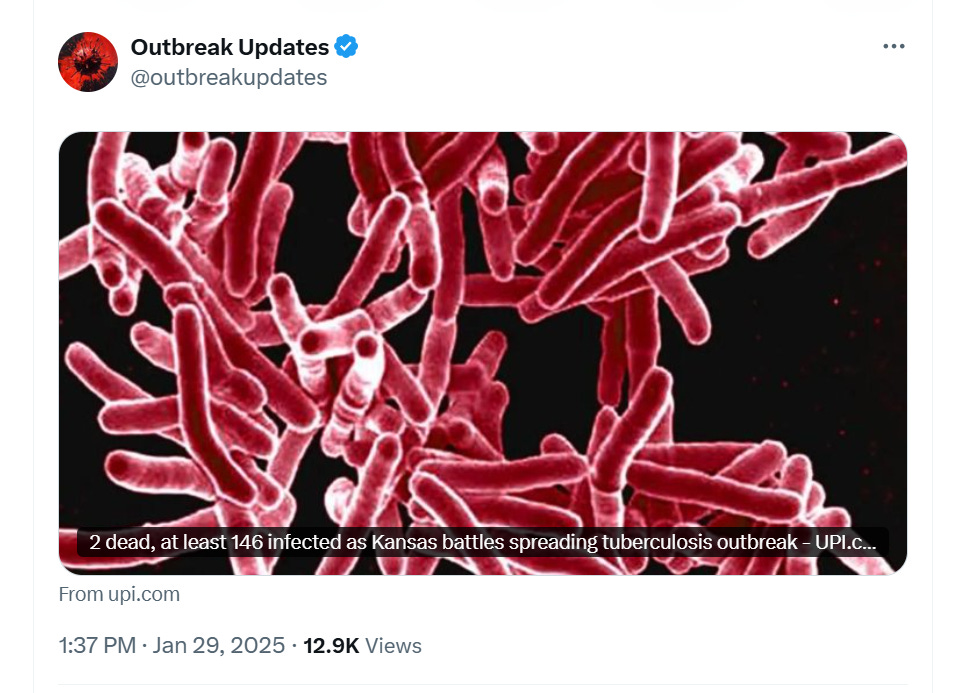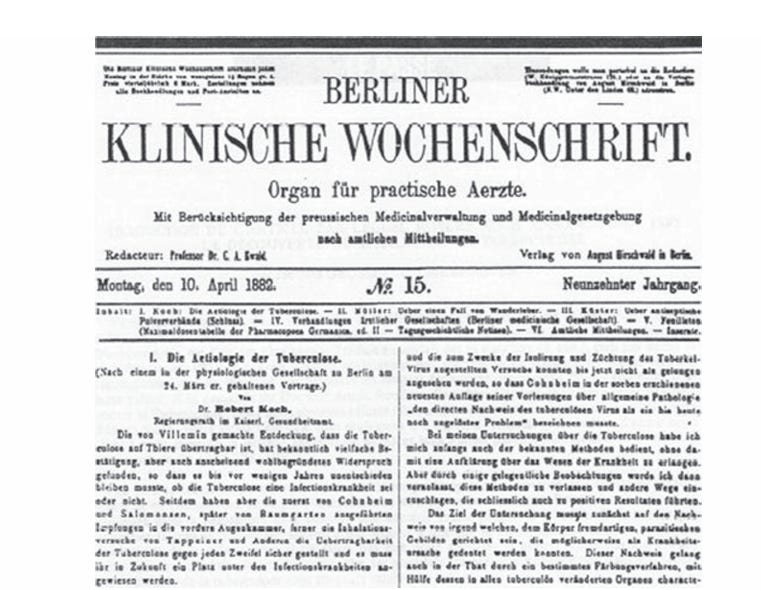Before the fake deadly measles outbreak in TX, we had a fake deadly tuberculosis (TB) outbreak in KS, remember? Here is the article linked to this post:
Despite the fear mongering headline, the article says that most of those people were not sick, and that TB is treatable by antibiotics. The article did not say how and why the 2 people died; presumably they didn’t get treated by antibiotics? Were they homeless drug users by any chance? We will never know. But the article mentions other TB outbreaks among homeless drug users.
While discussing this bogus story with some learned people, I was given this paper as a “proof” that TB is contagious via aerosol droplets! I wanted to find how this transmission mechanism was experimentally determined, so I read the paper and tried (in vain) to track down some references to the original experiments from it.
Prior to the microbe enthusiasm that erupted during the 19th century, for millennia, TB had been thought of as a hereditary or spontaneous illness, not something transmissible human to human. As a frequent reader of the 19th century literature, I read numerous descriptions of people with active TB, coughing up blood (the deadly droplets!!). Yet, invariably, none of them are shunned, nor isolated, nor masked. Nobody around them takes any special precautions to protect themselves from the droplets. They are taken care of by their immediate family and friends and none of those people get sick. Do you know the opera La Traviata by Giuseppe Verdi? A musical and poetic masterpiece, where the tragic heroine dies of TB in the arms of her lover who doesn’t get TB despite the prolonged intimate relationship with her? That’s a very typical experience with TB during the thousands of years that this illness was described, up until the mid 1800’s when directly observable experience in medicine was overrun by hairbrained ideas of “The Science”. “The Science” now claims that TB is contagious via aerosol droplets, period, and if you point to any contradictory evidence you are a crazy science denier.
The review article acknowledges this - thousands of years of ignorance, until everyone was “saved” by the microbe whisperers:
The transmission of ‘consumption‘ from a coughing patient to a healthy person was just unbelievable for people living before the nineteenth century because tuberculosis was considered to be inherited or congenital or spontaneous. Decades were needed to show that tuberculosis was transmitted from human to human, from human to animal or from animal to human. Interestingly, the first sentence of the seminal paper by Koch acknowledges previous work by Jean-Antoine Villemin (1827–1892), a French army doctor, who first demonstrated the transmissibility of tuberculosis.
It is claimed that Jean-Antoine Villemin, successfully transmitted tuberculosis from patient to rabbit, from cow to rabbit and from rabbit to rabbit as early as 1865. Two of his papers are cited as references, but none of them are available on the internet. I found a book describing his work, but it is in French. If any of my French-speaking readers can find anything in this book describing those experiments, I think all of us will be interested.
Edit, a helpful French-speaking reader provided the methodology by which Villemin famously demonstrated TB transmission. Behold:
Here's a translation (with comments) of experiment 1:
"On 6 March 1865, we took two bunnies. With one bunny we inserted into a small opening behind each ear two small fragments of tuberculosis,
and a little puriform liquid from a pulmonary cavity taken from the lungs and intestines of
a phtisic who had been dead for 33 hours. On 30 March and 4 April we repeated the inoculation with the other bunny.
On June 20 there were no appreciable changes in the health of the bunny (now a rabbit!) other than the fact that it had grown a lot (amazing!). We sacrified it and when we opened it, we noticed a teaspoon of serosity in the peritoneum, some swelling (tubercule)
along the curve of the stomach, on two parallel
tracks of each side of the median line, and formed with grey granulations, which were oblong, and very small. Some of those granulations had a tiny little yellow dot in the center.
In the intestine, there was a tubercule the size of a hempseed. (Yes, a hempseed. I know. And the French invented the metric system. Go figure.)
Other smaller tubercules which were less prominent were scattered in the small intestine.
Later, the brother of the first bunny was also killed and showed absolutely no "tubercule" when they opened him up.
So there you have it for experiment one.
Neither of the two bunnies died of consumption like Violetta in La Traviata. "Sempre libera..."
Britannica provides the following biography for Villemin and sheds some light on how Villemin “proved transmission” - by injection of course! That’s the only method to transmit the illness that doesn’t transmit. Of course the paper claims that injection and “contact” are the same thing. It claims that when Villemin injected putrid rotten matter it was the same as being in the presence of someone with active TB. Talk about fake science! Emphasis added:
Jean Antoine Villemin (born Jan. 28, 1827, Prey, Vosges, Fr.—died Oct. 6, 1892, Paris) was a French physician who proved tuberculosis to be an infectious disease, transmitted by contact from humans to animals and from one animal to another.
Villemin studied at Bruyères and at the military medical school at Strasbourg, qualifying as an army doctor in 1853. He was sent for further study to the Val-de-Grâce, the military medical school in Paris. As an army doctor he observed that healthy young men from the country often developed tuberculosis while living in the close quarters of the barracks. Aware that glanders in horses, a similar disease, is transmitted by inoculation, Villemin began his experiments by inoculating a rabbit with tuberculous material from a deceased human patient. Tuberculous lesions were found in the rabbit three months later. He also found that rabbits inoculated with tuberculous material from cows developed the disease.
His results, presented in 1867, were at first ignored. The French believed tuberculosis was hereditary, and German scientists knew that introducing a foreign body into a tissue would produce something like a tubercule. Villemin tried valiantly to champion the doctrine of contagion, but it was some time before his position was vindicated by the experiments of other scientists. He later proved by injection that sputum and blood from tubercular patients can transmit the disease to animals.
Thousands of years of observed reality told humans (even the French! :)) that TB was not contagious. Additionally, the German scientists knew that injecting foreign matter into the lungs is a bad idea and may lead to the destruction of the lungs (the TB disease). I would like to go back to 1867 when doctors and scientists still paid attention to reality… However, as we know, the sane doctors were defeated by the insane scientists right around that time:
The microbe hunters persevered.
Robert Koch is credited with the discovery of the TB bacilli for which he received the Nobel Prize.
On 24 March 1882, the German doctor Robert Koch communicated to the Berlin Society of Physiology that he had discovered the microorganism responsible for the deadly pulmonary tuberculosis, named Tuberkelvirus in his seminal publication made 2 weeks later.
Of course the image they provide is an unreadable blurry German…
As to the method by which Koch “discovered” the TB bacilli - it is clear he had a preconceived notion of the microbe as the causative agent (hardly an open-minded scientific search for truth) and was working hard to demonstrate the outcome he was after, i.e. find that “microbe”:
Staining tuberculosis bacteria was a first, decisive innovation made by R. Koch and his team. As stated by R. Koch himself, the goal was to demonstrate the presence of ‘foreign parasitic structures … indicative of the causal agent‘.
That first step - to stain the bacteria for microscopy in a sample from a patient with an active disease was a very convoluted process. It did not work at first, required prolonged soaking in the stain, heating, counterstaining, and several years of fiddling with the method until some structures in the samples could be stained blue, while others were brown. Koch insisted that the blue rod shapes were the causative agent of TB. As none of the original papers describing this are available (I wonder why?) it is not clear whether any controls were used while developing the staining methods.
Shockingly, at that time in science it was common knowledge that pictures of dead and colored (stained) particles did not provide evidence of the disease causation:
At that point, R. Koch noticed that the repeated observation of tubercle bacilli was not proof for this organism being the aetiological agent of tuberculosis.
Holy mackerel… Doctors and scientists today are completely convinced that pictures, cartoons and animations, and more recently - averaged consensus genome sequences (i.e. computer models) - are the proof of a global deadly pandemic and no other proof is necessary. We call this retardation “scientific progress”…
I am going to go on a tangent here. I have been lectured on this by several scientists on “our” side. Apparently, asking for proof of viral transmission from properly controlled experiments is very gauche of me. I was told that this is not necessary, and “observational evidence” can be used instead. For these people “observational evidence” includes creative re-interpreting of some ancient Egyptian murals. For example this one is now claimed by WHO and Wiki as proof(!) that viral polio existed back then:
The guy holding a very large martini has a wasted leg. Because polio virus! No other explanations for the damaged leg - birth defect/accident, other accidents, war injuries, injury on a pyramid construction site, an encounter with a Nile crocodile… in other words, the sorts of things that would be fairly common in Ancient Egypt - none are accepted by the “modern science”. Folks, this picture is proof of 3000 yo polio virus, end of story!
Well, not quite. Here is another shocking admission:
According to WHO: Egypt's last confirmed case of wild poliovirus was reported in 2004, and the country was declared polio-free in 2006. However, in September 2020, an environmental sample taken from a collection site in Giza tested positive for vaccine-derived poliovirus type 2 (VDPV2).
Someone should add the polio vax needle and a smiling face of Bill Gates-of-Hell to that ancient Egyptian meme…
Back to TB.
After Koch realized that the picture of the stained histopathological bacilli is not going to cut it as demonstration of causality of the TB, he went through some experimental contortions “isolating” the bacilli. Said contortions included cooking the bacilli juice, i.e. heating it several times, and then creating a solid precipitant in test tubes. After a certain period of time some growth was induced in the test tubes and he declared it the TB bacilli isolate. After injecting guinea pigs in the lungs with the produced growth - no surprise at all - the guinea pigs developed lung lesions. Who wouldn’t develop lung lesions if some cooked-and-let-to-rot matter was injected in their lungs? By the way, at least some of them would have developed lesions from having their lungs injected with saline! In 1867, the German scientists apparently knew this when they told Villemin to get lost. But by 1887 it was already too late! Koch was awarded the Novel Prize for this voodoo practices. Of course, as with all groundbreaking foundational papers in virology, his original paper describing these methods is not available anywhere online, and even if you find it, it will be a scan in some blurry unreadable German.
The Tuberculin Fiasco
I found another review paper on Koch which, likewise did not discuss any methods or experiments in detail, but hailed the genius who, having discovered the “true” cause figured out how to cure the TB. Except, the opposite happened.
in the autumn of 1890, Koch published a paper on the subject which began: "In a communication which I made a few months ago to the International Medical Congress, I described a substance of which the result is to make laboratory animals insensitive to inoculation of tubercle bacilli, and in the case of already infected animals, to bring the tuberculous process to a halt."
Koch cooked up a magic potion, which ultimately became known as “Tuberculin”. He was initially very secretive about its composition, but in 1891 he divulged that the substance was a filtrate from a growth of tubercle bacilli on glycerol broth. The announcement of a cure for tuberculosis, coming from a medical scientist of such distinction as Koch, immediately excited interest throughout the world. A Lancet editorial welcomed the news as "glad tidings of great joy" and the British Medical Journal was similarly enthusiastic. Both journals published a complete translation of Koch's paper. I can’t find either version online. Numerous TB sufferers sought Koch’s treatment.
The English physician and writer Sir Arthur Conan Doyle [the author of the Sherlock Holmes series] travelled to Berlin to investigate the claims, and Sir Joseph (later Lord) Lister took his tuberculous niece to Berlin, so that Koch could treat her himself. In the United States, 1000 dollars were offered for a teaspoon of the remedy.
The price tag is eye-watering. That’s approximately $35,000 per teaspoon today! Almost like the current gene therapies on the market that are priced $1-4M per treatment. No wonder the insane scientists overran the asylum. The money was simply too good. And, just like the gene therapies today, Koch’s Tuberculin failed rather spectacularly, by making many patients worse, by killing and injuring and not preventing anything. Koch produced a new version, but that one failed as well. He was (deservedly) vilified in press. Maybe this experience sobered him up a bit, because at the end of his career he opposed the push to proclaim that the bovine version of TB a public health hazard and drive the pasteurization of milk, which resulted in elimination of small family farms and consolidation of power in the hands of larger producers:
In 1901 the Third International Tuberculosis Congress was held in London. Koch spoke at this Congress and accepted the findings of Theobald Smith, but still maintained that tuberculosis in cattle was not an important danger to man and special preventative measures were unnecessary. This view provoked considerable opposition at the time.
[…]in 1908, at the Washington Congress on Tuberculosis, Koch still maintained that infection of man by the bovine bacillus was negligible and did not justify special preventative measures.
Today, raw milk is still demonized by the establishment and is still illegal in several states. And where it is available, it is extremely expensive.
For further reading on TB contagion history - excellent quotes and references in this post by Katherine Watt:
From Roman Bystranuk, full paper available here.
Art for today: Ranch 2, oil on panel, 9x12 in.











My grandmother, born in Newark in 1909 to Italian immigrants, had TB and spent many years in and out of the "sanitarium," where my mother was not allowed to visit her - foreshadowing covid lockdown, hmmm? All my mother got to see of her mother for much of her childhood was to stand under the upper floor window and talk to her that way. (Hey, you know us Italians - we yell anyway.) It was criminal. No wonder I cry when I watch Dumbo. My mom was shuffled around from relative to relative for years. One thing the experience gave her, though, was a good healthy mistrust of the medical industry. Even as far back as the 70s she was faking my siblings' vaccination cards. Go Mom!
The husband of a friend got TB years ago. He took several rounds of antibiotics, 2 different ones at a time, and healed. He is still alive and this is 20+ years ago. No one else got sick. I was told that he got it because of his extremely poor diet (he was an alcoholic and ate close to nothing).
I am wearing my Jeff Childers' Tshirt, Science (syringe) shut up! Indeed. Since science it seems most everything is going the wrong direction. Doctors might better keep to the only times they are really necessary - broken, ripped, ruptured, torn.... that is when they do great work. It would also save lots of money, to stop all these outrageous experiments on animals and humans.